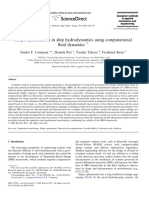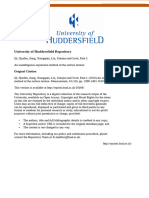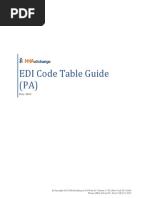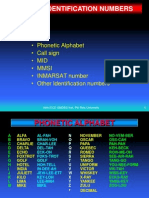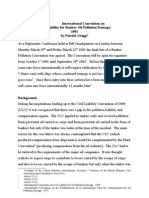Radial Basis Functional Model of Multi-Point Dieless Forming Process For Springback Reduction and Compensation
Radial Basis Functional Model of Multi-Point Dieless Forming Process For Springback Reduction and Compensation
Uploaded by
Carlos ArenasCopyright:
Available Formats
Radial Basis Functional Model of Multi-Point Dieless Forming Process For Springback Reduction and Compensation
Radial Basis Functional Model of Multi-Point Dieless Forming Process For Springback Reduction and Compensation
Uploaded by
Carlos ArenasOriginal Description:
Original Title
Copyright
Available Formats
Share this document
Did you find this document useful?
Is this content inappropriate?
Copyright:
Available Formats
Radial Basis Functional Model of Multi-Point Dieless Forming Process For Springback Reduction and Compensation
Radial Basis Functional Model of Multi-Point Dieless Forming Process For Springback Reduction and Compensation
Uploaded by
Carlos ArenasCopyright:
Available Formats
International Symposium on Green Manufacturing and Applications (ISGMA 2017) OP062
Radial Basis Functional Model of Multi-point
Dieless Forming Process for Springback
Reduction and Compensation
Misganaw Abebe Baye1, Ji-Woo Park1, Jeong Kim1, Beom-Soo Kang1,#
1 Aerospace Engineering, Pusan National University, Korea
# Corresponding Author / E-mail: bskang@pusan.ac.kr
KEYWORDS : Multi-point Dieless Forming, Springback, Radial Basis Function, Reduction, Compensation
Springback in multi-point dieless forming is a common problem because of the small deformation and blank holder
free boundary condition. Numerical simulations are widely used in sheet metal forming to predict the springback.
However, the computational time in using the numerical tools is time costly to find the optimal values of process
parameters or design variables. This study proposes radial basis function to replace the numerical simulation model
using statistical analyses based on a design of experiment method. Punch holding time before unloading of the upper
punch, blank thickness and curvature radius are chosen as effective process parameters for determining the
springback in the multi-point dieless forming process. The Latin hypercube design of experiment method facilitates
statistical analyses and the extraction of a prediction model for determining springback in the experimental process
parameter domain. Finite element simulation model is conducted in the ABAQUS commercial software to generate
the springback responses of the training and testing samples. The genetic algorithm is applied to find the optimal
value of curvature radii to compensate the induced springback for different blank thicknesses using the developed
RBF prediction model. Finally, the finite element simulation result of the optimal process parameters shows that the
springback is almost negligible from the target geometry.
ACKNOWLEDGEMENT
This work was supported by the National Research Foundation of Korea (NRF) grant funded by the Korea government (MSIP) through the
Engineering Research Center (No. 2012R1A5A1048294). Also, this work was supported by the Human Resource Training Program for the
Regional Innovation and Creativity through the Ministry of Education and National Research Foundation of Korea (NRF-2015H1C1A1035499).
90
You might also like
- C THR81 2405Document8 pagesC THR81 2405kutloano10hopolangNo ratings yet
- Patent of NativityDocument2 pagesPatent of Nativityjoe100% (6)
- Inspection, Maintenance and Repair of Maritime Structures Exposed To Damage and Material Degradation Caused A Salt Water EnvironmentDocument55 pagesInspection, Maintenance and Repair of Maritime Structures Exposed To Damage and Material Degradation Caused A Salt Water EnvironmentHauDucNguyen100% (3)
- Artificial Neural Networks For Machining Processes Surface Roughness ModelingDocument2 pagesArtificial Neural Networks For Machining Processes Surface Roughness ModelingAnnada Prasad MoharanaNo ratings yet
- Ilg 2019 IOP Conf. Ser. Mater. Sci. Eng. 651 012070Document9 pagesIlg 2019 IOP Conf. Ser. Mater. Sci. Eng. 651 012070ansys fluentNo ratings yet
- Prediction of Design Parameters in Ship Designing Based On Data Mining Technique by Combining Genetic Programming With Self Organizing MapDocument7 pagesPrediction of Design Parameters in Ship Designing Based On Data Mining Technique by Combining Genetic Programming With Self Organizing MapKarthi KeyanNo ratings yet
- Chaouch Et Al 2023 Modeling and Multi Objective Optimization of Abrasive Water Jet Machining Process of CompositeDocument11 pagesChaouch Et Al 2023 Modeling and Multi Objective Optimization of Abrasive Water Jet Machining Process of Compositevivek sahuNo ratings yet
- Numerical_Analysis_of_RCC_Beam_Using_ABAQUS (1)Document12 pagesNumerical_Analysis_of_RCC_Beam_Using_ABAQUS (1)KalyandakupatiNo ratings yet
- Content ServerDocument22 pagesContent ServerIgnacius Garridum ContulianoNo ratings yet
- Improved Particle Swarm Optimization For The Determination of Chaboche Model Parameters of The Elastoplastic Behavior Railway SteelDocument10 pagesImproved Particle Swarm Optimization For The Determination of Chaboche Model Parameters of The Elastoplastic Behavior Railway SteelInternational Journal of Innovative Science and Research TechnologyNo ratings yet
- SLA VS SLA VS FDMDocument9 pagesSLA VS SLA VS FDMZiyad AbouelkasemNo ratings yet
- Feature Investigation On The ROP MachineDocument7 pagesFeature Investigation On The ROP Machinehishamhakimi321No ratings yet
- Toward Design Optimization of A Pelton Turbine RunnerDocument15 pagesToward Design Optimization of A Pelton Turbine RunnerRalney FariaNo ratings yet
- XXXXXXXXXXXX Proof XXXXXXXXXXXXXXXDocument16 pagesXXXXXXXXXXXX Proof XXXXXXXXXXXXXXXficuniNo ratings yet
- Optimization of High-Pressure Die-Casting Process Parameters Using Artificial Neural NetworkDocument8 pagesOptimization of High-Pressure Die-Casting Process Parameters Using Artificial Neural NetworkSamuel gc333No ratings yet
- Resume PDFDocument3 pagesResume PDFAnkit KumarNo ratings yet
- Optimization of FDM 3D Printing Process Parameters On ABS Based Bone Hammer Using RSM TechniqueDocument13 pagesOptimization of FDM 3D Printing Process Parameters On ABS Based Bone Hammer Using RSM TechniqueJohnNo ratings yet
- Selection of a Design for Response SurfaceDocument15 pagesSelection of a Design for Response SurfaceRhanaNo ratings yet
- Lee2014 Article OptimizationProcessForConceptDDocument6 pagesLee2014 Article OptimizationProcessForConceptDmaroineNo ratings yet
- 1 s2.0 S2238785418301467 MainDocument22 pages1 s2.0 S2238785418301467 MainBharat VinjamuriNo ratings yet
- Rao 2007Document8 pagesRao 2007adugna taddeseNo ratings yet
- Isogeometric Analysis Using T-SplinesDocument35 pagesIsogeometric Analysis Using T-SplinesLeonardoMadeira11No ratings yet
- Product Re-Engineering by Topology Optimization For Forged ComponentDocument5 pagesProduct Re-Engineering by Topology Optimization For Forged ComponentWARSE JournalsNo ratings yet
- 23 09 2023 From Roman PHD - Maksym - Literature ReviewDocument339 pages23 09 2023 From Roman PHD - Maksym - Literature ReviewmkryvoshNo ratings yet
- Shape Optimization in Ship Hydrodynamics Using ComputationalDocument18 pagesShape Optimization in Ship Hydrodynamics Using ComputationalFatwa AzamNo ratings yet
- 1 s2.0 S1110016817300686 MainDocument11 pages1 s2.0 S1110016817300686 Mainankan_papuNo ratings yet
- J Anucene 2017 01 035Document15 pagesJ Anucene 2017 01 035zhangheng zhangNo ratings yet
- Model Updating Using Genetic Algorithms With Sequential Niche TechniqueDocument17 pagesModel Updating Using Genetic Algorithms With Sequential Niche TechniqueShruti SharmaNo ratings yet
- Energy & Buildings: Zhihong Pang, Zheng O'Neill, Yanfei Li, Fuxin NiuDocument29 pagesEnergy & Buildings: Zhihong Pang, Zheng O'Neill, Yanfei Li, Fuxin NiuRajendra RokaNo ratings yet
- applsci-14-11416Document30 pagesapplsci-14-11416Nida AkNo ratings yet
- Nayeri 2013Document8 pagesNayeri 2013m.kiran babuNo ratings yet
- AIAA20025539 StanderDocument10 pagesAIAA20025539 Standerger5555kingNo ratings yet
- Multi-Point Optimization On The Diffuser of An Axial Flow PumpDocument7 pagesMulti-Point Optimization On The Diffuser of An Axial Flow Pumpalper yeterNo ratings yet
- Guruku TersayangDocument11 pagesGuruku TersayangAdi QCNo ratings yet
- 2022 FDM ConferenceDocument12 pages2022 FDM Conferencekuldeep sharmaNo ratings yet
- University of Huddersfield Repository: Original CitationDocument10 pagesUniversity of Huddersfield Repository: Original Citationhr.gosp.hrNo ratings yet
- Application of Machine Learning To Bending ProcessDocument24 pagesApplication of Machine Learning To Bending ProcessBudi santoso BudiNo ratings yet
- Materials and Design: Anoop Kumar Sood, R.K. Ohdar, S.S. MahapatraDocument9 pagesMaterials and Design: Anoop Kumar Sood, R.K. Ohdar, S.S. MahapatraRui MatiasNo ratings yet
- 1 s2.0 S152661252030027X MainDocument12 pages1 s2.0 S152661252030027X MainNilesh KumarNo ratings yet
- Cable Robot ThesisDocument5 pagesCable Robot ThesisBuyEssaysTulsa100% (2)
- A Simplified Computational Method For Random Seismic Responses of A Jacket PlatformDocument6 pagesA Simplified Computational Method For Random Seismic Responses of A Jacket PlatformXavierJacobNo ratings yet
- Progressive Addition LensesDocument9 pagesProgressive Addition LensesMiguel ZunigaNo ratings yet
- N7 Logic Via Patterning Using Templated DSA Implementation AspectsDocument12 pagesN7 Logic Via Patterning Using Templated DSA Implementation AspectsWanghlNo ratings yet
- Modeling and Process Parameter Optimization of Laser Cutting Based On Artifcial Neural Network and Intelligent Optimization AlgorithmDocument12 pagesModeling and Process Parameter Optimization of Laser Cutting Based On Artifcial Neural Network and Intelligent Optimization Algorithm532110007No ratings yet
- Resume - Sachin RavindranDocument1 pageResume - Sachin RavindranJosh pokeNo ratings yet
- A Collaborative Iterated Greedy Algorithm With Reinforcement Learning For Energy-Aware Distributed Blocking Flow-Shop SchedulingDocument23 pagesA Collaborative Iterated Greedy Algorithm With Reinforcement Learning For Energy-Aware Distributed Blocking Flow-Shop SchedulingAyoub OuhadiNo ratings yet
- Thermal Analysis and Performance of A Connecting Rod With Different MaterialsDocument3 pagesThermal Analysis and Performance of A Connecting Rod With Different Materialsredwan al-mustafaNo ratings yet
- APIN2012Document15 pagesAPIN2012lisa kustinaNo ratings yet
- Design Optimization of The Lines of The Bulbous BowDocument12 pagesDesign Optimization of The Lines of The Bulbous BowFernando Raúl LADINONo ratings yet
- StASaER MOODocument14 pagesStASaER MOOAuref RostamianNo ratings yet
- 10 - A Surrogate Modelling Strategy To Improve The Surface Morphology Quality 2023Document14 pages10 - A Surrogate Modelling Strategy To Improve The Surface Morphology Quality 2023yasin yapiciNo ratings yet
- Assessment of Printed Circuit Board SolderabilityDocument4 pagesAssessment of Printed Circuit Board SolderabilitysmtdrkdNo ratings yet
- Study On Parametric Optimization of Fused Deposition Modelling (FDM) ProcessDocument207 pagesStudy On Parametric Optimization of Fused Deposition Modelling (FDM) ProcessfamilyumaNo ratings yet
- Arabzadeh2018 Article ConstructionCostEstimationOfSp PDFDocument10 pagesArabzadeh2018 Article ConstructionCostEstimationOfSp PDFSyahrul FitraNo ratings yet
- Mathematical Modeling For Radial Overcut On Electrical Discharge Machining of Incoloy 800 by Response Surface MethodologyDocument10 pagesMathematical Modeling For Radial Overcut On Electrical Discharge Machining of Incoloy 800 by Response Surface MethodologySai SrinivasNo ratings yet
- Machine Learning Based Decline Curve Analysis ForDocument23 pagesMachine Learning Based Decline Curve Analysis ForLívio GonçalvesNo ratings yet
- Quality Prediction and Classification of ResistanceDocument17 pagesQuality Prediction and Classification of ResistanceJahaziel BorjaNo ratings yet
- Sahu 2013Document16 pagesSahu 2013avt01No ratings yet
- Mixed-Fidelity Design Optimization of Hull Form Using CFD and Potential Flow SolversDocument15 pagesMixed-Fidelity Design Optimization of Hull Form Using CFD and Potential Flow Solversheinz billNo ratings yet
- 1 s2.0 S2238785419309858 MainDocument9 pages1 s2.0 S2238785419309858 Mainsundar.jkm02No ratings yet
- E Thesis Nitrkl AcDocument6 pagesE Thesis Nitrkl AcRaquel Pellicier100% (1)
- FG 023Document8 pagesFG 023Carlos ArenasNo ratings yet
- Friction Stir Incremental Forming of A2017 Aluminum SheetsDocument6 pagesFriction Stir Incremental Forming of A2017 Aluminum SheetsCarlos ArenasNo ratings yet
- 3D Model Based Boat Hull Design and Manufacturing: - InformatikaDocument3 pages3D Model Based Boat Hull Design and Manufacturing: - InformatikaCarlos ArenasNo ratings yet
- Finite Element Simulation of Residual Stress Profiles in Peen Forming ProcessDocument1 pageFinite Element Simulation of Residual Stress Profiles in Peen Forming ProcessCarlos ArenasNo ratings yet
- Jamech: Numerical and Experimental Analysis and Optimization of Process Parameters of AA1050 Incremental Sheet FormingDocument11 pagesJamech: Numerical and Experimental Analysis and Optimization of Process Parameters of AA1050 Incremental Sheet FormingCarlos ArenasNo ratings yet
- Build Code Analysis With Symbolic Evaluation: Make Make Make MakeDocument11 pagesBuild Code Analysis With Symbolic Evaluation: Make Make Make MakeCarlos ArenasNo ratings yet
- Icmp2014 5014Document3 pagesIcmp2014 5014Carlos ArenasNo ratings yet
- Seamless Superconducting RF CavitiesDocument4 pagesSeamless Superconducting RF CavitiesCarlos ArenasNo ratings yet
- New Tools For The Selection of Technologies Application To Sheet Metal FormingDocument5 pagesNew Tools For The Selection of Technologies Application To Sheet Metal FormingCarlos ArenasNo ratings yet
- United States Patent (19) : Park Et Al. (11) Patent NumberDocument10 pagesUnited States Patent (19) : Park Et Al. (11) Patent NumberCarlos ArenasNo ratings yet
- Forming A Trust: Legal & Finance Legal & FinanceDocument16 pagesForming A Trust: Legal & Finance Legal & FinanceCarlos ArenasNo ratings yet
- Fti09 084Document1 pageFti09 084Carlos ArenasNo ratings yet
- Data Handover ChecklistDocument1 pageData Handover ChecklistCarlos ArenasNo ratings yet
- Landjobopagou 2020Document15 pagesLandjobopagou 2020GhulamNo ratings yet
- Motor Detroit d13 Con PtoDocument2 pagesMotor Detroit d13 Con PtoingdanielmarroquinNo ratings yet
- EDI+Code+Table+Guide PACHCDocument21 pagesEDI+Code+Table+Guide PACHCAida NotiNo ratings yet
- Overview Opennac Org Eng v9Document42 pagesOverview Opennac Org Eng v9JUNFERNNo ratings yet
- HIRADC Asphalt RoadDocument1 pageHIRADC Asphalt RoadAshadi Amir100% (1)
- Sec 19 (3) Employer AppointmentDocument2 pagesSec 19 (3) Employer Appointmentridhwaan singhNo ratings yet
- Brochure-Portable Blood Gas AnalyzerDocument2 pagesBrochure-Portable Blood Gas AnalyzerMelina GutierrezNo ratings yet
- Digital Fluency VJDocument27 pagesDigital Fluency VJsushma harishNo ratings yet
- 3 Call Signs Mms MidDocument42 pages3 Call Signs Mms MidSalam AlecuNo ratings yet
- 32.2021 KF7600L Leaflet ENG - v1.2Document8 pages32.2021 KF7600L Leaflet ENG - v1.2Mohamed EssamNo ratings yet
- Maintenance Manual For Laboratory EquipmentDocument169 pagesMaintenance Manual For Laboratory EquipmentOumaima H'rNo ratings yet
- Fyp 1Document51 pagesFyp 1Tarani TharanNo ratings yet
- J-T-M-G-, AXXX XXX 080 (BIA Oct. 21, 2016)Document4 pagesJ-T-M-G-, AXXX XXX 080 (BIA Oct. 21, 2016)Immigrant & Refugee Appellate Center, LLC100% (2)
- Rural Marketing of Hero HondaDocument41 pagesRural Marketing of Hero HondaAJAYNo ratings yet
- Presentation Track Crack 1531731357 350135Document13 pagesPresentation Track Crack 1531731357 350135004ICEDhanooj SNo ratings yet
- Alembic QRGDocument11 pagesAlembic QRGAjayNo ratings yet
- A Data Driven Residential Transformer Overloading Risk Assessment MethodDocument10 pagesA Data Driven Residential Transformer Overloading Risk Assessment MethodEdna LópezNo ratings yet
- Piston Ring ManfDocument3 pagesPiston Ring ManfMahesh AtyaleNo ratings yet
- PalmGHG V4 Manual-EnglishDocument9 pagesPalmGHG V4 Manual-EnglishAndria AnriaNo ratings yet
- Csc443 Test 2Document13 pagesCsc443 Test 2muhammad ali imranNo ratings yet
- Chapter 6 Management Control A. The Basic Elements of The Control ProcessDocument15 pagesChapter 6 Management Control A. The Basic Elements of The Control ProcessAudra Joy San JuanNo ratings yet
- June 2019 QPDocument16 pagesJune 2019 QPdaimon6407No ratings yet
- CONTRACT TO SELL Vacant LotDocument4 pagesCONTRACT TO SELL Vacant LotAdrian CanlasNo ratings yet
- Subcont - PT Pulauintan Bajaperkasa Konstruksi - PekerjaanDocument3 pagesSubcont - PT Pulauintan Bajaperkasa Konstruksi - Pekerjaangendut_novriNo ratings yet
- Life Sciences p1 QP Gr11 Nov 2018 - EnglishDocument18 pagesLife Sciences p1 QP Gr11 Nov 2018 - Englishzintlemagudu12No ratings yet
- How Does Magnetism in Pipes Stop The Welding ProcessDocument5 pagesHow Does Magnetism in Pipes Stop The Welding ProcessMujahid BalochNo ratings yet
- Imo Bunker ConventionDocument16 pagesImo Bunker Conventionpari2005No ratings yet
























